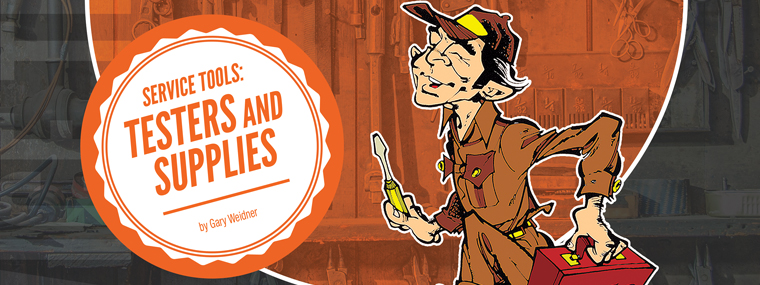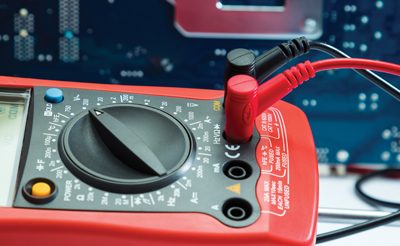
Service Tech Training: Service Tools: Testers and Supplies
By Gary Weidner / Published December 2015

Editor’s Note: This service technician training series was published previously from September 2008 through June 2014 in Cleaner Times|IWA. It is being republished with the recognition this material is not exhaustive of the subject at hand, but rather to present to new servicepeople an all-important fundamental understanding of how things work.
So far, this series has covered basic ideas about being a pressure washer serviceperson, the range of basic and essential tools needed, optional but very useful tools, and devices to aid changing pump oil. You may be wondering when we’ll explore actually using all these things and doing service work. The answer is “soon,” but first let’s touch upon still more of our arsenal by looking at some testers and supplies.
Testers—Gauges and Such
The most commonly used gauge is almost certainly the one used to measure the pressure in the discharge line of a pressure washer. It is usually equipped with quick couplers and frequently has a temperature gauge mounted in the same assembly. A word of caution: the kind of rough use these gauges get makes them prone to loss of calibration. It is wise to check the reading of your pressure gauge frequently so you can be confident that its readings are reasonably accurate.
Whether you’re working in the shop or on the road, there’s almost always time pressure. One small way to save time is to build a collection of adapters for use in testing. If you can adapt your gauge set quickly and easily to other sizes and types of quick couplers and fittings, you will be a better and faster troubleshooter. In addition to adapters, a collection of hose barbs, worm clamps, and assorted fittings, such as male-male and female-female, makes it no hassle to implement various test setups.
 Here’s another time-saver: keep on your truck a short section of high pressure hose (about 12 ft long), fitted with quick couplers, and a test gun to snap onto the hose. It can be faster than dealing with a customer’s 50- or 100-ft hose when testing a machine. With it, keep a selection of new wash tips in various sizes, quick-coupled to plug onto the test gun. You don’t want to be checking machine pressure using a customer’s worn wash tip. And since the customer’s tip will very often be worn, a simple comparison of pressures with the old and new tips will show him or her that they are losing out on a few hundred psi. It’s an easy way to sell tips on many service calls and feel good about helping the customer.
Here’s another time-saver: keep on your truck a short section of high pressure hose (about 12 ft long), fitted with quick couplers, and a test gun to snap onto the hose. It can be faster than dealing with a customer’s 50- or 100-ft hose when testing a machine. With it, keep a selection of new wash tips in various sizes, quick-coupled to plug onto the test gun. You don’t want to be checking machine pressure using a customer’s worn wash tip. And since the customer’s tip will very often be worn, a simple comparison of pressures with the old and new tips will show him or her that they are losing out on a few hundred psi. It’s an easy way to sell tips on many service calls and feel good about helping the customer.
These are some other useful gauges:
• Fuel pressure gauge for oil burners—usually 0–200 or 0–300 psi.
• Gas pressure gauge for gas burners—usually 0–15 in. water column.
• Vacuum gauge—usually 0–30 in. mercury, for checking the suction side of water or fuel pumps.
• Water line pressure gauge—usually 0–100 psi, to check incoming pressure. Save time by mounting the gauge on a tee equipped with garden hose fittings so it can be easily inserted in the water line.
Testers—Electrical
If you could only have one electrical test device, it would have to be the versatile “multimeter.” The cheapest of these meters retails for less than $15 and allows you to measure ac and dc voltage, resistance, continuity, and small currents. The more expensive models handle many other measurements, but also be sure to look for ruggedness.
When you don’t need the full capabilities of the multimeter, here are three test lights that are faster and easier to use:
• 6/12/24 volt test light—for ac or dc, available from automotive suppliers.
• 120/240/480 volt test light—neon lamp. These are often rated for a range of 80–600 volts. I like the Ideal model 61-040. It has long leads, nice probes, and it’s rugged.
• Continuity test light—a bulb (or “LED”) and battery power. This is good for tracing wiring or checking switches. LEDs are preferable to the traditional light bulb because they have much lower battery drain and they almost never burn out.
Another important tester is the clamp-on ammeter, used to measure current drawn by motors. Some of these can also perform multimeter functions.
Your electrical kit should include “cheater cords” for 120 volt and 240 volt power. Use them to quickly and easily connect power to a machine with no plug. It’s also a big help to have several “clip leads” to assist in troubleshoot-
ing. (Radio Shack is a good source.)
Testers—Engines
These items are valuable for servicing engine-driven pressure washers:
• Battery load tester—applies electrical load to a battery and monitors voltage under load, which indicates the health of the battery.
• Battery hydrometer—tests the electrolyte solution in non-sealed batteries.
• Antifreeze hydrometer—tests the freeze-point of an antifreeze solution.
• Tachometer—for gasoline engines, the hand-held electronic, wireless type is excellent. For diesel engines, try using a vibration-sensing tachometer. These devices are wonderfully simple and reliable (no battery or electronics). Mine comes from Treysit (www.treysit.com).
• Compression gauge—sometimes very helpful, although limited by the fact that many small engines have automatic cranking compression release schemes.
• Starter test switch—available from automotive suppliers, this is a rugged pushbutton switch with two clip leads attached. It can be very useful in trouble-shooting.
Although the following would have to be considered tools, not testers,
you would do well to have them:
• Battery terminal cleaning brushes—there are versions for top post and for side-connection batteries.
• Battery terminal puller—don’t risk damaging a battery post or cable clamp by prying off the clamp.
• Battery terminal spreader—don’t risk damaging a cable clamp by spreading it unevenly with a screwdriver. The spreader opens the clamp evenly, without distorting it.
• Spark plug wire puller—have you ever gotten a jolt when pulling a spark plug wire from a running engine, or simply had trouble getting a boot off? I like the KD #135.
Supplies
These are some commodities you’ll find helpful:
• Aerosols
• Battery terminal spray—seals clean terminals to keep them from corroding
• Starting fluid (“ether”)
• Carburetor/choke cleaner
• White lithium grease
• All-purpose lubricant, such as WD-40
• Other commodities
• Petroleum jelly
• Anti-seize compound
• Thread locking compound
• Pipe dope
• Baking soda (for cleaning the battery terminals)
• Household glue
• RTV sealant
• Anti-oxidant grease (prevents corrosion of electrical connections)
• Spray-n-wipe cleaner
• Hand cleaner
Odds ‘N’ Ends
• Vinyl electrical tape—in addition to the usual black color, consider also carrying green electrical tape for marking ground wires
• Masking tape (1-in. wide)—use for temporary taping/securing during a repair, and you can write on it to mark wires
• Spare roll of Teflon thread tape
• Rags or disposable wipers
• Emery cloth or sandpaper
• Cotton swabs (“Q-Tips”)
• Steel wool
• Emery boards (get at a cosmetics department)
• Sticks from ice pops
• Some plain steel wire (such as 16-gauge tie-wire, available at construction supply houses)
Whew! With all these lists presented, we’re about ready to go into servicing itself.






